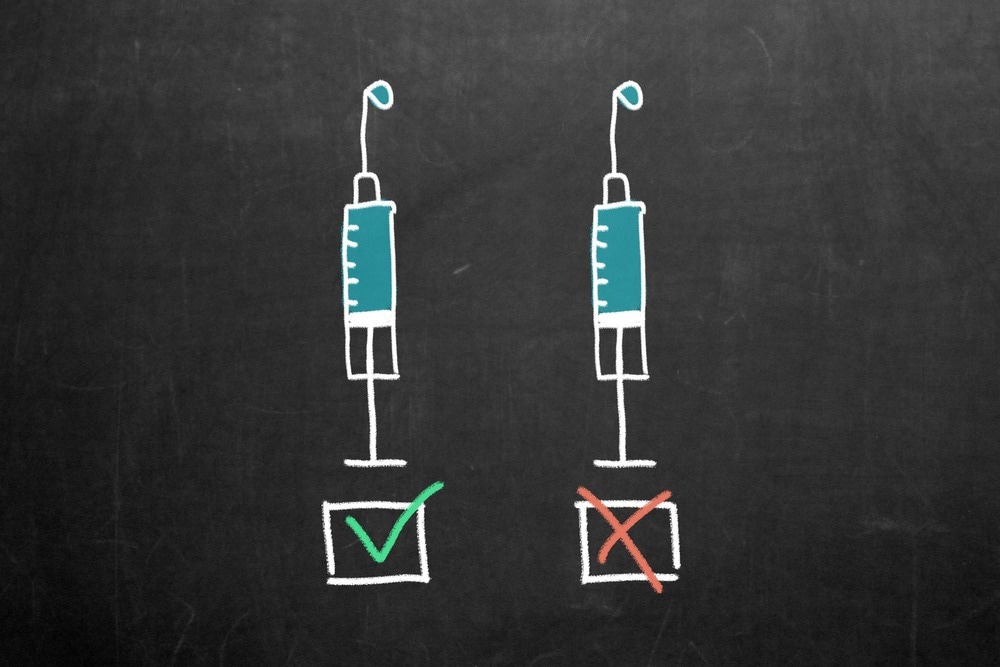In a recent study published in the journal Vaccines, researchers reviewed existing literature to determine the factors influencing the perceptions on and acceptance of coronavirus disease 2019 (COVID-19) vaccines among healthcare workers and professionals.

Study: Determinants of Acceptance of COVID-19 Vaccination in Healthcare and Public Health Professionals: A Review. Image Credit: Giulio Benzin / Shutterstock.com
Background
The morbidity and mortality associated with the severe acute respiratory syndrome coronavirus 2 (SARS-CoV-2) outbreak, declared a pandemic in March 2020 by the World Health Organization (WHO), has decreased significantly since COVID-19 vaccines were distributed throughout the world later that year.
Vaccines have proven to be the most effective method of limiting the spread of infectious diseases. However, general misconceptions and misinformation about vaccines have resulted in a significant level of vaccine hesitancy, particularly during the COVID-19 pandemic.
The WHO prioritized the vaccination of frontline workers during the COVID-19 pandemic, as these individuals were at the most significant risk of contracting SARS-CoV-2 infection. COVID-19 vaccination was aimed at protecting these workers and preventing the secondary spread of SARS-CoV-2.
However, the rapid pace at which COVID-19 vaccines were developed has led to concerns and decreased vaccine uptake among healthcare workers and public health professionals. Since these individuals are in a position to influence patients' opinions towards vaccines, it is essential to understand the factors contributing to vaccine hesitancy among healthcare workers.
About the study
In the present study, researchers conducted a literature review of peer-reviewed studies that evaluated the sentiments of healthcare workers about COVID-19 vaccination and analyzed the determinants of and barriers to vaccine uptake. Longitudinal, cohort, and cross-sectional studies, as well as systematic and scoping reviews and meta-analysis studies, were included in the review.
The investigated population comprised public health professionals and healthcare workers, with measured outcomes including perceptions of the investigated population toward COVID-19 vaccines.
One grey literature and 299 articles from PubMed were retrieved using keywords, 44 of which were excluded, as they did not evaluate vaccine-associated sentiments of healthcare workers. An initial screening of the abstract and title was used to exclude another 172 studies, whereas a full-text review excluded 28 studies that did not focus on the investigated population or measured outcome.
A total of 56 studies were considered for the final review. These studies were conducted in various countries worldwide and evaluated vaccine-associated perceptions of physicians, nurses, midwives, pharmacists, dentists, healthcare workers, and pediatricians.
Study findings
The COVID-19 vaccine uptake rate was highest at about 99% in a cross-sectional study from Italy, while a global scoping review among nurses and a cross-sectional study among midwives and nurses in Cyprus reported the lowest vaccine uptake rates of 20.7% and 30%, respectively.
Various demographic factors were associated with COVID-19 vaccine uptake rates. Except for studies conducted in Saudi Arabia, Cyprus, and Greece, studies across Europe and the Middle East reported that male healthcare workers were more receptive to receiving the COVID-19 vaccine than female healthcare workers.
With the exception of five studies from China, Egypt, Italy, and Palestine, the results largely indicated that healthcare workers between the ages of 30 and 50 were more likely to get vaccinated against COVID-19 than younger healthcare workers of 18 and 30.
When ethnicity was explored as a determinant of vaccine hesitancy, non-White healthcare workers were less likely to be vaccinated against COVID-19. For example, one study from the United Kingdom reported that vaccine hesitancy among Pakistani, Black Caribbean, Chinese, Mixed White, Black Caribbean, Black African, and other White ethnicities were 68.3%, 43.1%, 65.6%, 59.5%, 60.2%, and 69%, respectively, as compared to White British healthcare workers. However, the results from some studies contrasted with each other regarding vaccine uptake rates among Asian healthcare workers.
Education levels correlated positively with vaccine acceptance rates, with studies from various countries showing an association between higher education levels and increased vaccine uptake. Healthcare workers with comorbidities or chronic diseases were also more inclined to receive the COVID-19 vaccine than those who did not have comorbidities.
Furthermore, individuals with a history of receiving the influenza vaccine were more receptive to being immunized against COVID-19.
The study also suggested that risk versus benefit analyses were vital in determining sentiments and perceptions toward COVID-19 vaccines. Psychological factors such as susceptibility, increased risk perception, and fear of COVID-19 increased vaccine uptake rates, with the need to protect oneself and one's family, close contacts, and patients being motivating factors to increase vaccine uptake among healthcare workers. Health literacy and a sense of social and collective responsibility also increased vaccine acceptance among healthcare workers.
Conclusions
Overall, vaccine hesitancy among healthcare workers was associated with specific demographic factors such as age, gender, ethnicity, and the presence of comorbidities. Furthermore, risk-benefit analyses played an important role in influencing healthcare workers' perceptions toward the COVID-19 vaccine.
- Ghare, F., Meckawy, R., Moore, M., & Lomazzi, M. (2023). Determinants of Acceptance of COVID-19 Vaccination in Healthcare and Public Health Professionals: A Review. Vaccines, 11(2), 311. doi:10.3390/vaccines11020311
Posted in: Medical Science News | Medical Research News | Disease/Infection News | Healthcare News
Tags: Chronic, Coronavirus, Coronavirus Disease COVID-19, covid-19, Education, Healthcare, Influenza, Mortality, Pandemic, Public Health, Respiratory, SARS, SARS-CoV-2, Severe Acute Respiratory, Severe Acute Respiratory Syndrome, Syndrome, Vaccine
.jpg)
Written by
Dr. Chinta Sidharthan
Chinta Sidharthan is a writer based in Bangalore, India. Her academic background is in evolutionary biology and genetics, and she has extensive experience in scientific research, teaching, science writing, and herpetology. Chinta holds a Ph.D. in evolutionary biology from the Indian Institute of Science and is passionate about science education, writing, animals, wildlife, and conservation. For her doctoral research, she explored the origins and diversification of blindsnakes in India, as a part of which she did extensive fieldwork in the jungles of southern India. She has received the Canadian Governor General’s bronze medal and Bangalore University gold medal for academic excellence and published her research in high-impact journals.
Source: Read Full Article
